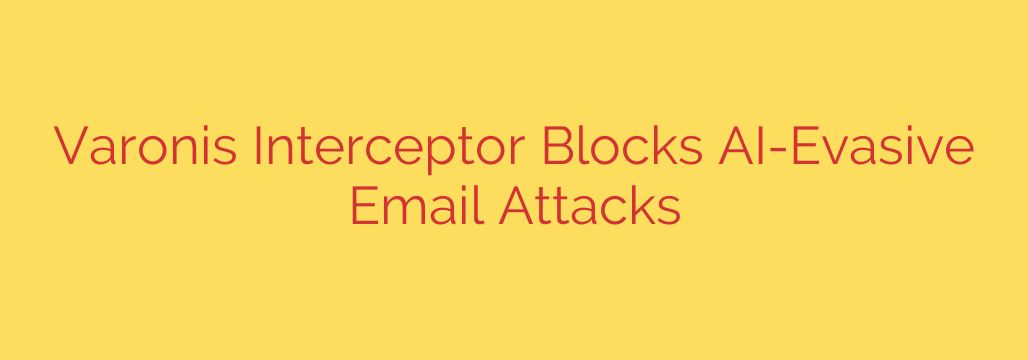
AI-Evasive Email Attacks: The Next Frontier in Phishing and How to Fight Back
In the ongoing battle for cybersecurity, organizations have increasingly relied on artificial intelligence to power their email security gateways. These advanced systems are trained to spot the tell-tale signs of phishing, malware, and spam. But what happens when threat actors learn to outsmart the AI itself? A new and alarming trend is on the rise: AI-evasive email attacks, which are specifically engineered to slip past the very defenses designed to stop them.
These sophisticated attacks represent a significant evolution in cybercrime, exploiting the blind spots in automated security filters. By understanding how these attacks work, you can better prepare your organization to defend against them.
What Are AI-Evasive Email Attacks?
AI-evasive email attacks are malicious campaigns that use clever obfuscation techniques to hide their dangerous content from AI scanners. While the email may look perfectly normal or slightly unusual to the human eye, its underlying code is structured to be misread or misinterpreted by security software.
The goal is simple: deliver a malicious payload, such as a phishing link or malware, directly to an employee’s inbox. The core strategy is to create a discrepancy between what the security AI sees and what the end-user sees. This allows the threat to bypass detection and land in a trusted environment, where a single click can lead to a devastating data breach.
Common Evasion Techniques Used by Attackers
Cybercriminals are constantly innovating, and their methods for fooling AI are both creative and effective. Here are some of the most common techniques being used in the wild:
- Zero-Font and Hidden Characters: Attackers embed malicious links with invisible characters or text set to a font size of zero. The AI scanner may read a fragmented, harmless string of text, while the user’s browser or email client correctly renders the full, clickable malicious link.
- Base64 Encoding and Obfuscation: Hackers encode malicious URLs or script components using Base64 or other methods. Many basic security scanners won’t decode and analyze this content, allowing it to pass through unchecked. The code is then decoded by the browser once the user opens the email or clicks a link.
- HTML Manipulation and Cloaking: This technique involves using complex HTML and CSS to hide or “cloak” the malicious elements. For example, a harmful link might be placed inside an invisible
<div>tag or layered underneath a harmless image. The AI scans the visible, benign content, completely missing the hidden threat. - QR Code Phishing (Quishing): Instead of a text-based link, attackers embed a QR code in the email. Most email security tools are designed to analyze text and URLs, not images. An unsuspecting user might scan the code with their phone, which takes them directly to a phishing site, completely bypassing the corporate network’s security perimeter.
Why Traditional AI Defenses Are Falling Short
The problem isn’t that AI-based security is ineffective; it’s that it has been trained to look for specific patterns, keywords, and sender reputations. AI excels at content analysis—judging the sentiment of a message or identifying a known malicious URL.
However, AI-evasive attacks are not a failure of content analysis, but a failure of context and structural analysis. The systems are not being “tricked” into thinking the content is safe; they are being prevented from seeing the malicious content at all. This creates a critical security gap that threat actors are actively exploiting.
A New Approach: Seeing What the User Sees
To effectively combat these advanced threats, security solutions must evolve. The next generation of email security needs to go beyond simple content scanning and start analyzing the fundamental structure of an email.
The most effective defense is a system that can render and inspect an email exactly as a web browser would. This approach allows the security tool to see the final, user-facing version of the message and compare it against the underlying code. By doing this, it can instantly spot discrepancies, such as:
- Links that are hidden or cloaked by HTML tricks.
- Text that is invisible to the user but present in the code.
- Encoded scripts or URLs that become malicious after rendering.
This “browser-like” analysis closes the gap that attackers exploit, ensuring that what the security tool inspects is the same thing your employee is about to click on.
Actionable Steps to Protect Your Organization
Defending against AI-evasive attacks requires a proactive and multi-layered security posture.
- Enhance Your Detection Capabilities: Relying solely on a standard secure email gateway (SEG) is no longer enough. Investigate and implement security solutions that specialize in analyzing the HTML structure of emails and can detect advanced obfuscation techniques.
- Educate Your Employees: Human awareness remains a critical line of defense. Train employees to be suspicious of any email that prompts urgent action, contains QR codes, or has unusual formatting. Encourage a “when in doubt, report it” culture.
- Implement Multi-Factor Authentication (MFA): Even if an employee’s credentials are stolen via a phishing attack, MFA provides a crucial barrier that can prevent unauthorized account access.
- Adopt a Zero-Trust Model: Assume that threats can and will get inside your perimeter. A zero-trust framework helps limit the potential damage by restricting access and continuously verifying user and device identity.
The threat landscape is dynamic, and as defenders adopt AI, attackers will continue to find ways to subvert it. By understanding the mechanics of AI-evasive attacks and adopting a more sophisticated, structural approach to email security, you can ensure your organization stays one step ahead of the next wave of cyber threats.
Source: https://www.helpnetsecurity.com/2025/10/08/varonis-interceptor/








